Black and white snakes are common across the world. This color combination is seen in different forms.
The combination of black and white colors is common in stripes, blotches, and other types of markings.
Snakes can have a black dorsal and a white underbelly. They can also have a black or white band across their body.
Some snakes are known for having a unique chessboard-like black and white pattern.
Black and white snakes can also be seen across the world both in venomous and non-venomous subspecies.
These snakes live in forests, meadows, chaparral, marshes, lakes, and ponds.
Black and white snakes are also found in the US.
Table of Contents
Are black and white snakes venomous?
Black and white snakes don’t represent a species of snakes. Their coloring gathers them under a common physical trait.
Black and white snakes encompass members of various species that may or may not be venomous.
- Venomous – a small percentage of black and white snakes are venomous. Western Massasauga is some of the most dangerous black and white venomous snakes.
Their venom may not be fatal with the right medical treatment. However, people can die when bitten by this snake when there’s no medical treatment.
- Mildly venomous – many types of black and white snakes are mildly venomous.
The Puget Sound Gartersnake is one of the snakes with poisonous saliva which is now considered a mildly venomous species. This snake was considered not venomous just a few decades ago.
- Non-venomous – these types of snakes aren’t considered dangerous to people. They may still bite but without any health risks.
Black and white non-venomous species include the Speckled Kingsnake. This species is known for not having any venom but it resists the bites of multiple other venomous snakes including pit viper snake bites.
The non-venomous nature of black and white snakes doesn’t necessarily exclude the venomous nature. Some non-venomous black and white snakes are known to resist the bites of venomous snakes.
Furthermore, non-venomous black and white snakes can also eat juvenile venomous snakes.
Types of black and white snakes
1. Puget Sound Gartersnake
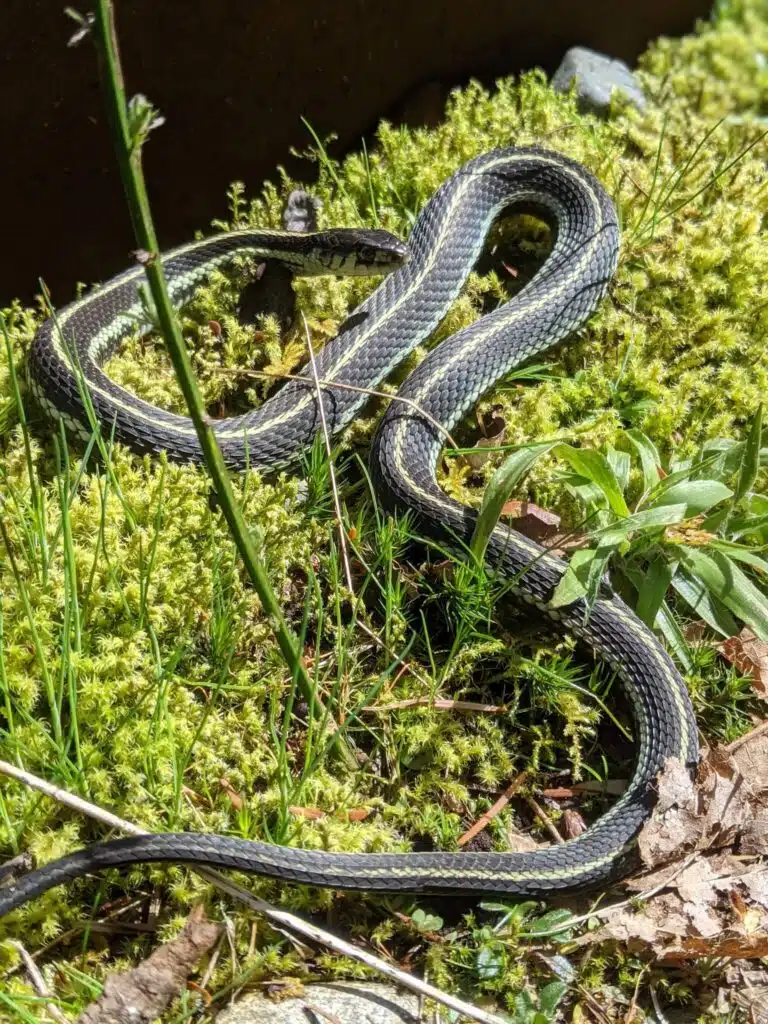
Scientific name: Thamnophis sirtalis pickeringii
Common name: Puget sound Gartersnake
The Puget Sound Gartersnake is a black species with either white, yellow, or blue narrow stripes.
This species is found in many habitats around the world as it has very good adaptability. Unlike many other species, the Puget Sound Gartersnake has changed its status from non-venomous to venomous.
Snakes of this species are now considered venomous.
They only produce mild venom which cannot harm people. However, this venom might still trigger allergic reactions.
Gums of this species are the toxic mouthparts as these snakes have no rear fangs.
This snake species is also known in the scientific world as the only snake species to resist tetrodotoxin, a powerful toxin in the animal world.
As a result, the snake can eat salamander species other snakes can’t. It eats Newt salamander frequently.
2. Gopher Snake
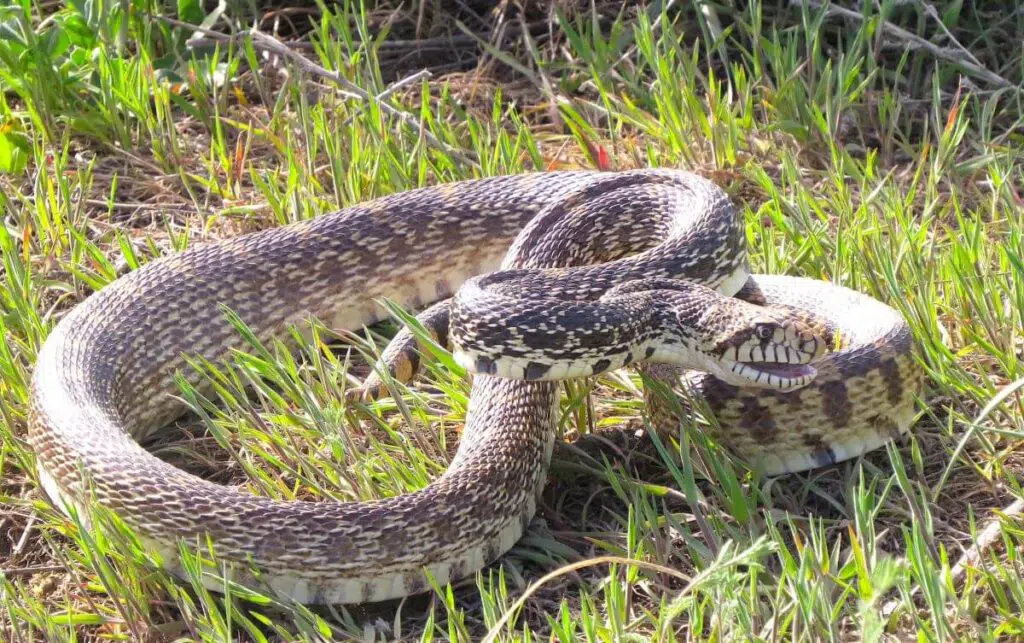
Scientific name: Pituophis catenifer
Common name: Pacific gopher snake, Henry snake, coast gopher snake, bullsnake, Churchill’s bullsnake, Oregon bullsnake, Pacific pine snake, western bullsnake, western gopher snake, Sonoran gopher snake, western pine snake, great basin gopher snake, blow snake, yellow gopher snake, gopher snake
Gopher snakes are sometimes mistaken for Rattlesnakes due to their black and white coloring which is sometimes rare.
But Gopher snakes can come in black and white coloring, as they can come in beige and brown coloring.
These snakes are very common in the US. Gopher snakes are the most common species in certain states due to their adaptability.
They live in all habitats from deserts to high mountain slopes.
Their black and white blotches make these snakes visible in marshes where they might eat lizards.
Gopher snakes prefer rodents and rabbits.
3. Black rat snake
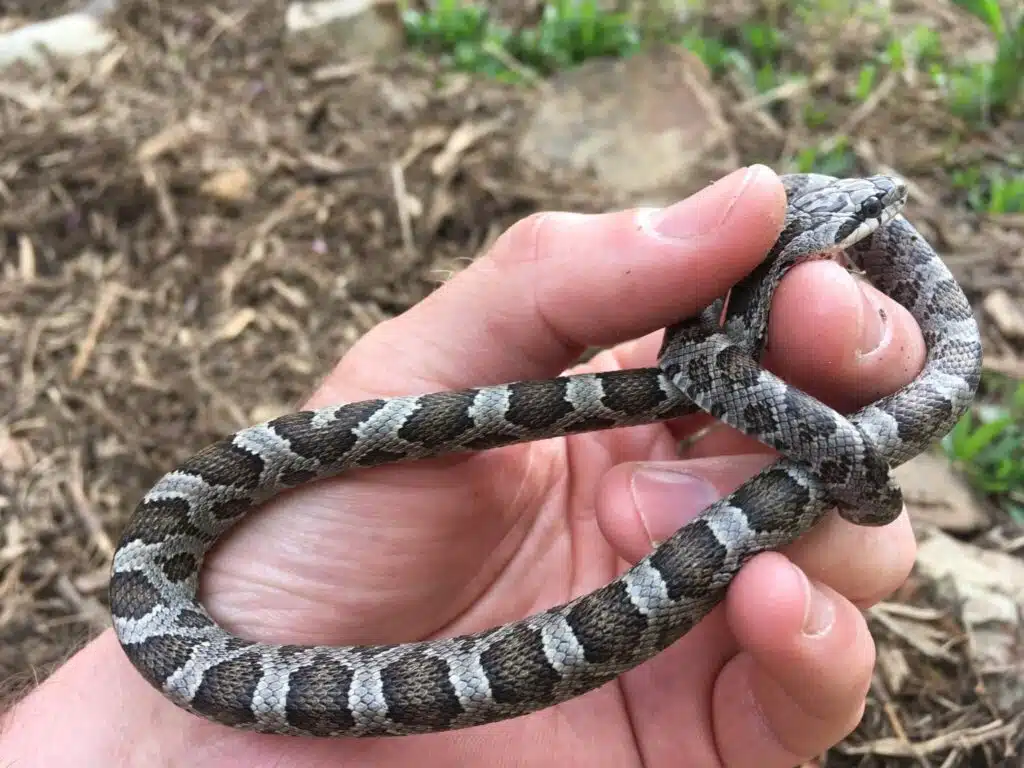
Scientific name: Pantherophis obsoletus
Common name: Western rat snake, black rat snake, pilot black snake, black snake
Black rat snakes are some of the most representative species for this type of physical appearance. These snakes are almost entirely black or they appear black from certain angles.
But Black rat snakes have a white mouth. They have white lives and throats which might only be visible when these snakes move around.
This snake species isn’t venomous, but it’s a feared constrictor and climber.
Common in the US, the Black rat snake is among the species that can climb trees fast.
These snakes use constriction to catch prey such as birds and rodents.
4. Eastern Ratsnake
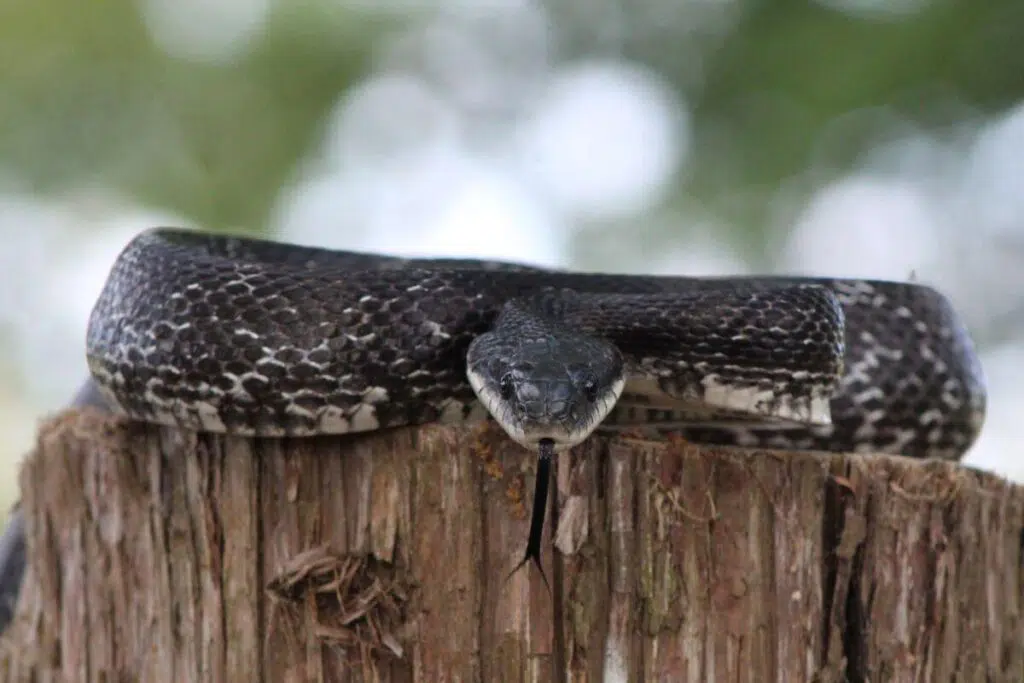
Scientific name: Pantherophis alleghaniensis
Common name: Eastern ratsnake, black rat snake, pilot snake, pilot black snake, chicken snake, yellow rat snake, Everglades rat snake
The Eastern Ratsnake is also partially black and white. It has a black and white chessboard-pattern underbelly.
Its dorsal coloring is mostly dark gray.
Like most black and white snakes, Eastern Ratsnakes live in different types of environments.
These snakes are found in forests and on farms. They are also common in homes, especially in the attic as the species is arboreal.
Hibernation is important for the species and this is why it seeks out the warmest spots to overwinter.
Its diet is comprised of rodents, lizards, and frogs.
5. Western Terrestrial Garter Snake
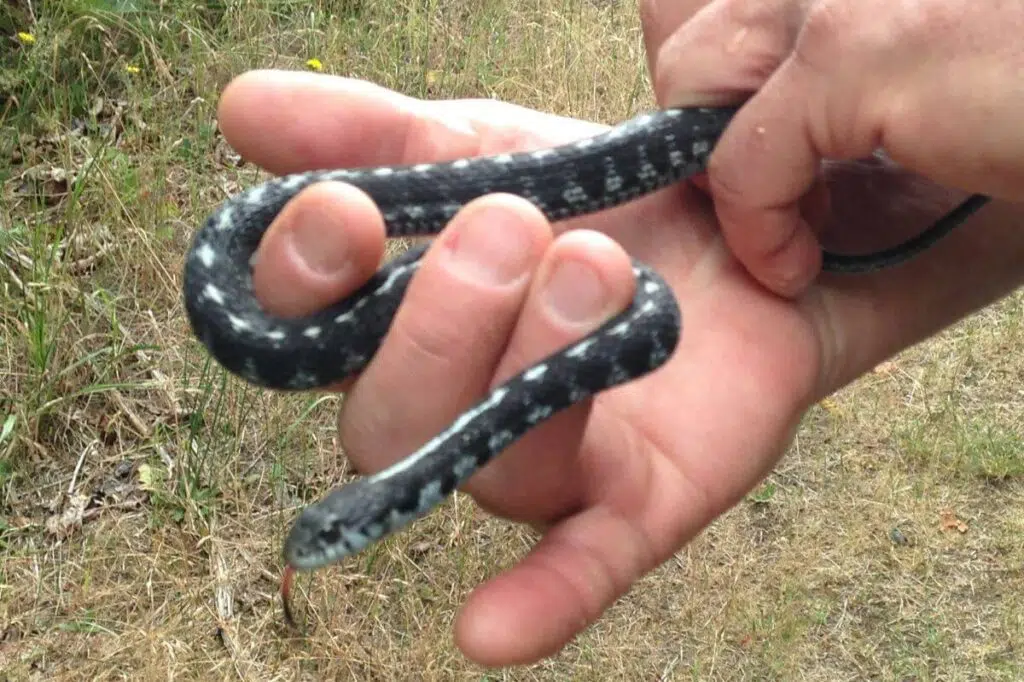
Scientific name: Thamnophis elegans
Commom name: Western terrestrial garter snake
This snake species comes in multiple colors. A common coloring includes black dorsal patterns and a white line with a gray-green body.
This species is also seen in orange and black patterns with white dorsal lines.
Western Terrestrial Garter snakes are mildly venomous.
They do not have a fully toxic venom but toxic saliva instead. This type of toxic saliva is what makes small prey vulnerable as it attacks their capacity to move.
In rare cases, this snake also bites people. Its mild venom comes with no serious reactions but local pain or swelling in the area of the bite.
6. Gray Ratsnake

Scientific name: Pantherophis spiloides
Common name: Central ratsnake, chicken snake, midland ratsnake, pilot black snake, gray ratsnake
This non-venomous snake species is also known for its contrasting colors. It has a dark gray to black dorsal and a white ventral side.
Snakes of this genus are very common in the US and Canada.
They prefer forests and habitats around streams.
Snakes of this genus are considered agile. They are among the most recognizable species when it comes to the capacity to quickly climb trees.
Their climbing abilities are used to look for prey or to escape potential predators.
Snakes of this genus eat all types of birds and rodents captured through constriction.
7. California King Snake
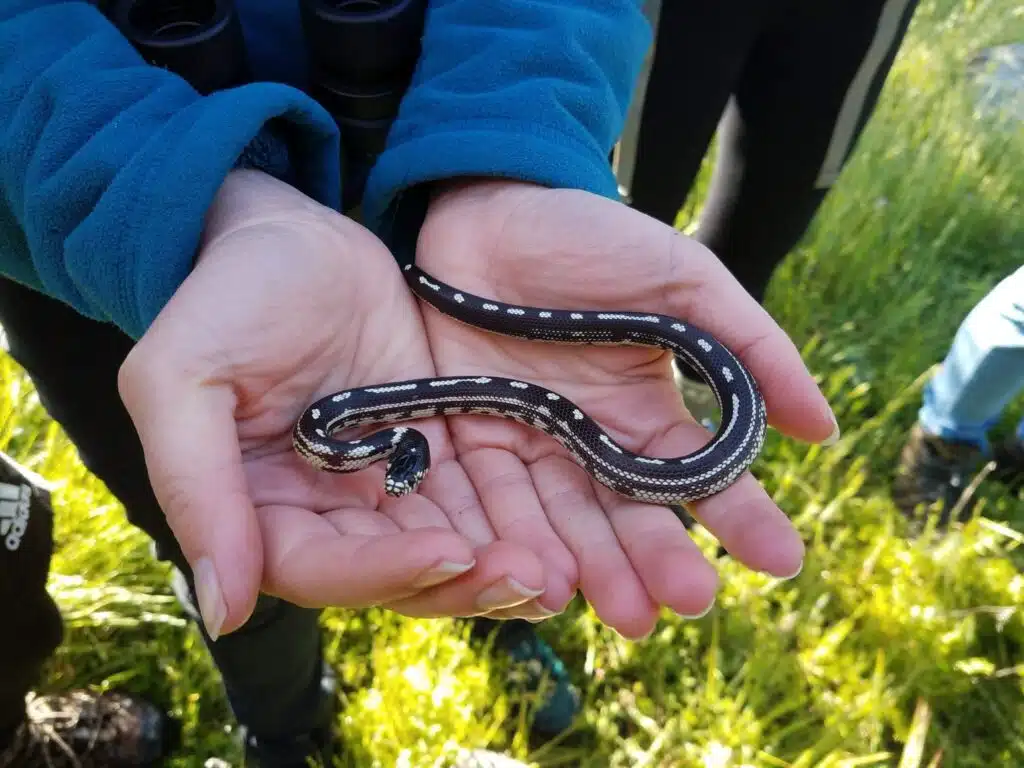
Scientific name: Lampropeltis californiae
Common name: California king snake
The California King Snake is also a species that comes in multiple colors from pink to dark brown. This snake is also seen in a black and white body.
The black and white coloring of the species is known to be based on alternating black and white stripes.
As a non-venomous species, this snake is still capable of dealing with venomous snakes.
The California King Snake resists bites of other venomous snakes.
While it doesn’t produce any venom itself, it can easily kill other venomous snake species through constriction and resistance to venomous bites.
This is one of the largest black and white snakes in the US. It grows to a maximum size between 2.5 and 3.5 feet.
8. Speckled Kingsnake
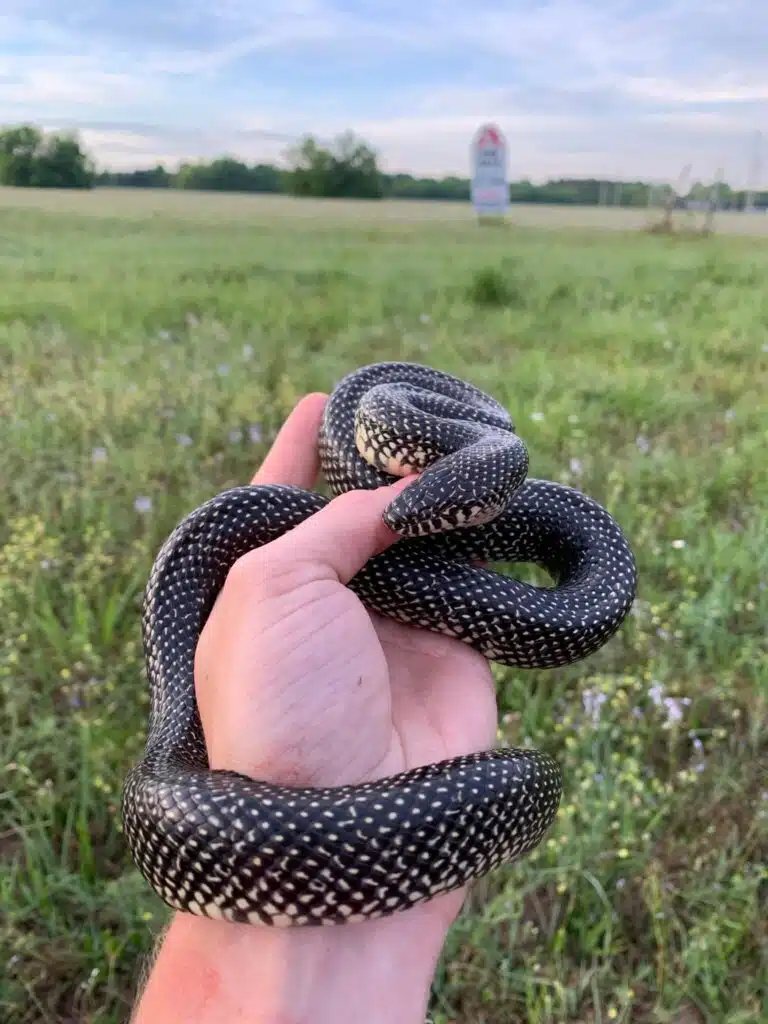
Scientific name: Lampropeltis holbrooki
Common name: Speckled kingsnake
Speckled Kingsnakes are known for their speckled bodies. These are black and white or black and off-white speckles which make these snakes easy to identify.
Black and white alternative speckles are seen on the dorsal and the ventral of these snakes.
Known as nonvenomous, Speckled Kingsnakes live in wet habitats such as swamps and rivers.
These snakes are known to use constriction against frogs and lizards.
They also exhibit defensive tactics against larger predators such as releasing a bad odor.
Snakes of this genus might also keep predators away using other techniques.
They can also expel feces to try and keep predators away. This is also a mimicking act where the snake plays dead.
9. Long-nosed Snake

Scientific name: Rhinocheilus lecontei
Common name: Long-nosed snake
This snake is known for its black banding and red banding on its dorsal and white underbelly.
Non-venomous Long-nosed snakes are endemic to North America yet still largely unknown to many.
This snake has a secretive life as it mostly lives underground and occasionally comes out of its hiding place to find salamanders and amphibians.
These snakes are also known for eating rodents whenever their favorite prey isn’t available.
People shouldn’t worry when seeing this snake as it doesn’t know how to bite. It only uses techniques such as releasing bad odors or blood to appear dead.
10. Eastern Kingsnake
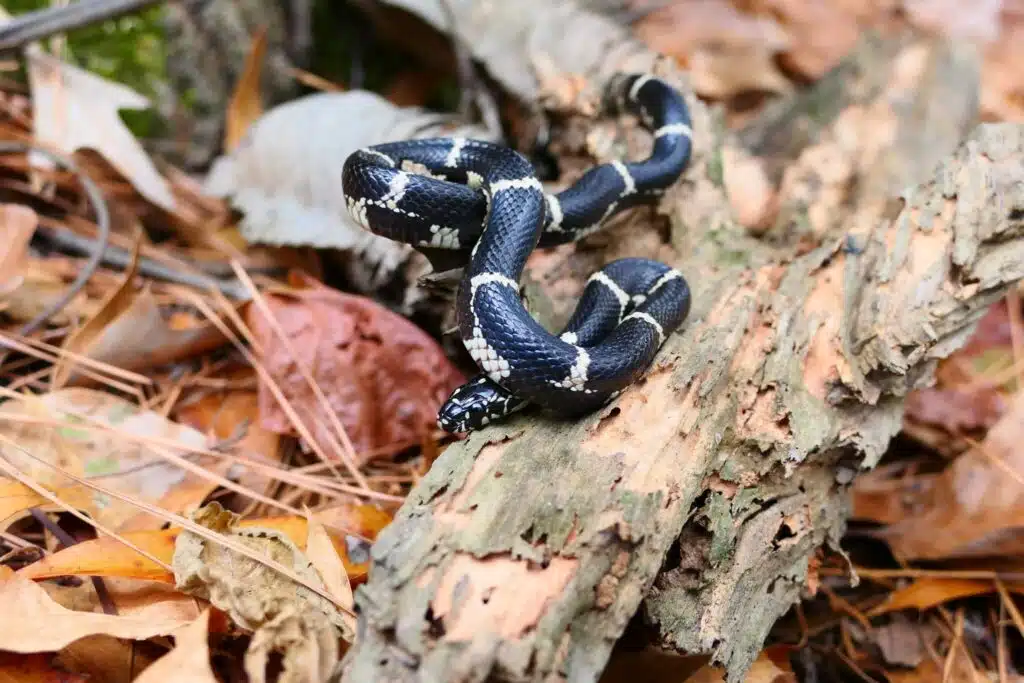
Scientific name: Lampropeltis getula
Common name: Eastern kingsnake, common kingsnake, chain kingsnake, kingsnake, Carolina kingsnake, chain snake, bastard horn snake, black kingsnake, black moccasin, common chain snake, cow sucker, eastern kingsnake.
Eastern Kingsnakes are almost completely black with just a few off-white bands across the body.
These snakes are protected in many US states such as Georgia.
Eastern Kingsnakes have a special status as they eat venomous snakes. While they only grow up to 48 inches, Eastern Kingsnakes are known for eating Copperheads and Cottonmouth venomous snakes.
Eastern Kingsnakes can be seen when females lay eggs under logs and rocks. This typically happens from August to September.
Eastern Kingsnakes can also be seen in the same burrows of venomous snakes such as Cottonmouths during the winter.
Some of the most common threats to these snakes include a diminishing natural habitat as well as Imported Red Fire Ants.
11. Black Kingsnake
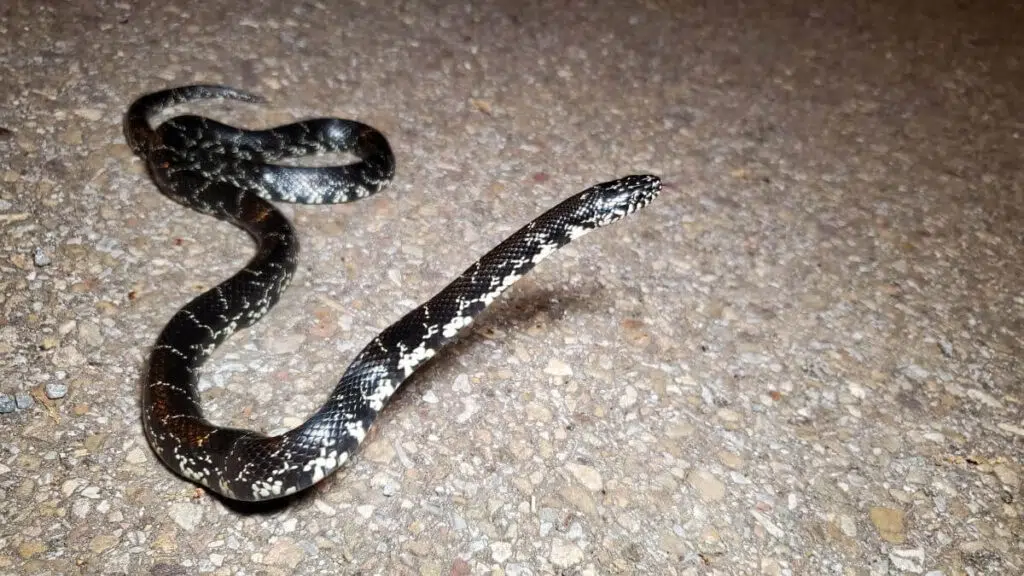
Scientific name: Lampropeltis nigra
Common name: Black kingsnake
The Black Kingsnake or the Eastern Black Kingsnake is a subspecies of the Common Kingsnake.
Snakes of this species are black with white or yellow-white crossbands or speckles.
These non-venomous snakes are known to prefer streams and wetlands. They can also move away from these to forests and areas with vegetation.
Like all Kingsnakes, the Black Kingsnake is known to resist the venom of venomous snakes.
The capacity to eat venomous snakes has led to the nickname of King among snakes.
12. Striped Whipsnake
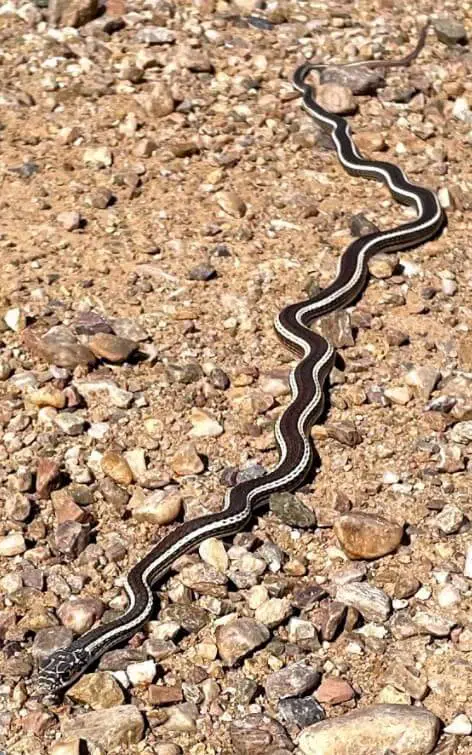
Scientific name: Masticophis taeniatus
Common name: Striped whipsnake
Striped Whipsnakes get their names from their striped bodies. These types of snakes are known for exhibiting a few white-yellow stripes and a dark to a black body.
These snakes have yellow stripes towards the tail which turn white closer to the head.
Striped Whipsnakes are well-adapted to living in animal burrows and under rocks or leaves.
These snakes primarily feed on lizards but they’re also known for eating other snakes.
While not venomous, Striped Whipsnakes are known for eating venomous snakes. They can survive the venom of Rattlesnakes which they often eat.
Juvenile Rattlesnakes are often eaten by Striped Whsipsnakes.
13. Western Massasauga
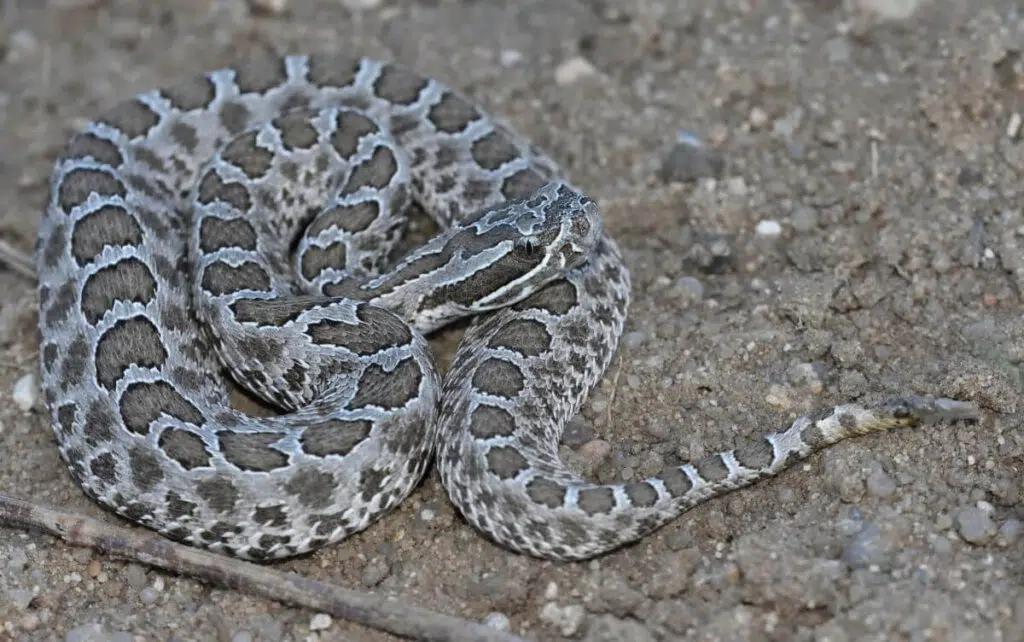
Scientific name: Sistrurus tergeminus
Common name: Western massasauga
These snakes are known for having black or brown dorsal blotches with a white outline and faded gray appearance.
Snakes of this genus can have small variations in coloring depending on their environment.
Commonly found in marshes during the winter, these are also common in prairies and woodlands.
This species is highly venomous and should not be handled.
As a Rattlesnake, the Western Massasauga snake is known for using venom against a series of small mammals such as rodents.
14. Pine Snake
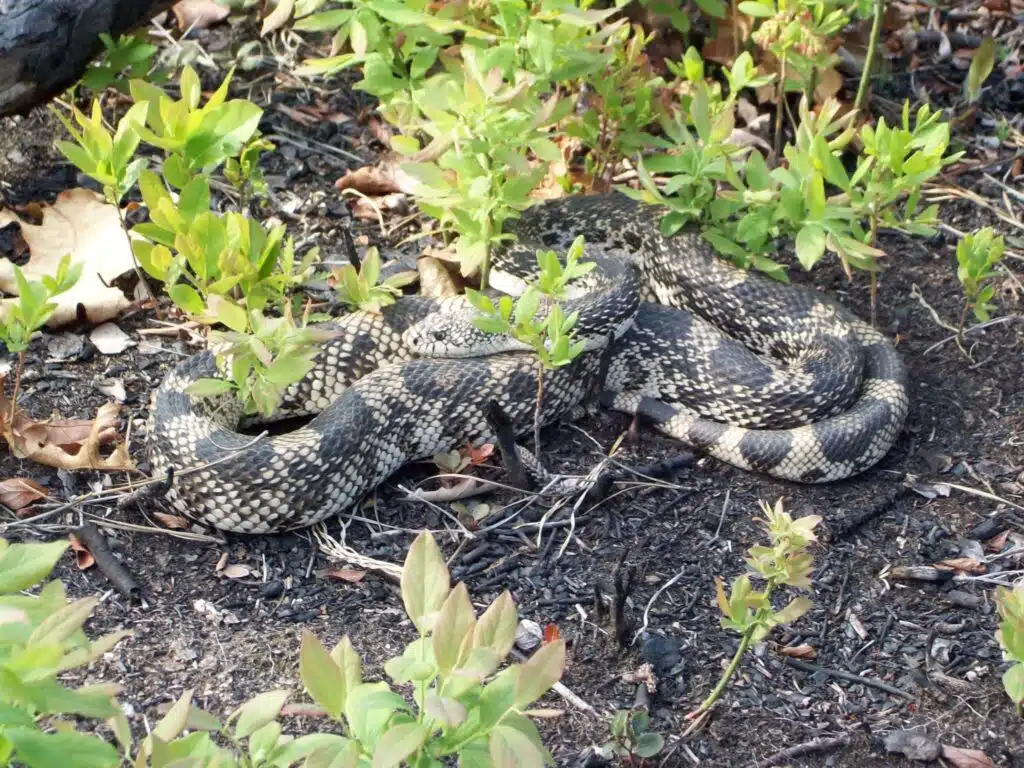
Scientific name: Pituophis melanoleucus
Common name: Pine snake
Pine Snakes are also known as Black and White snakes. This species comes in many colors including black and white.
Known not to be venomous, Pine Snakes use a type of constriction to catch small mammals such as rodents.
These snakes enter the burrows of certain mammals such as rats and mice. It’s here they constrict or push these rodents against walls eating them one by one.
It’s common for Pine Snake to eat multiple rodents in the same burrow visit as its blocks the small mice or rats from escaping by pinning them against the walls with its body.
15. Southern Black Racer
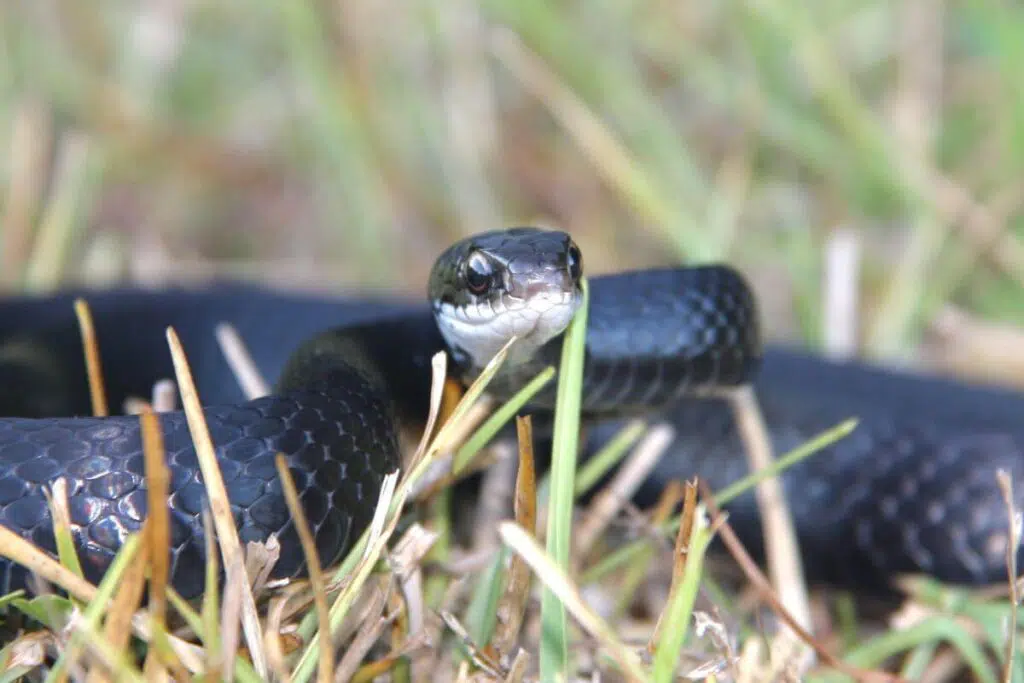
Scientific name: Coluber constrictor priapus
Common name: Southern black racer
This species of black snake is known for having a white chin and a white throat.
Common in North America, the snake is almost completely black. It only has white coloring around its mouth and it resembles the Indigo Snake (which has dark red mouth coloring).
Known as a non-venomous species, Southern Black Racers grow up to 56 inches.
These snakes eat insects, lizards, small snakes, moles, and mice.
They might resort to constriction to overpower certain types of prey, especially rodents.
Snakes of the genus can suffocate rodents with their strong constriction movements. This preying method is frequently used when the snake enters rodent nests.
Summary
Black and white snakes are common in the US. A part of these snakes is known for mainly being black and white while other snakes are also known for having black and white color variations.
Most black and white snakes aren’t truly venomous. Largely non-venomous, these snakes can sometimes be handled.
Most importantly, black and white snakes make excellent pet snakes as they look intriguing. Contrasting colors are never more different than black and white.
Further Reading: